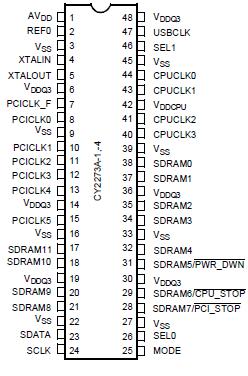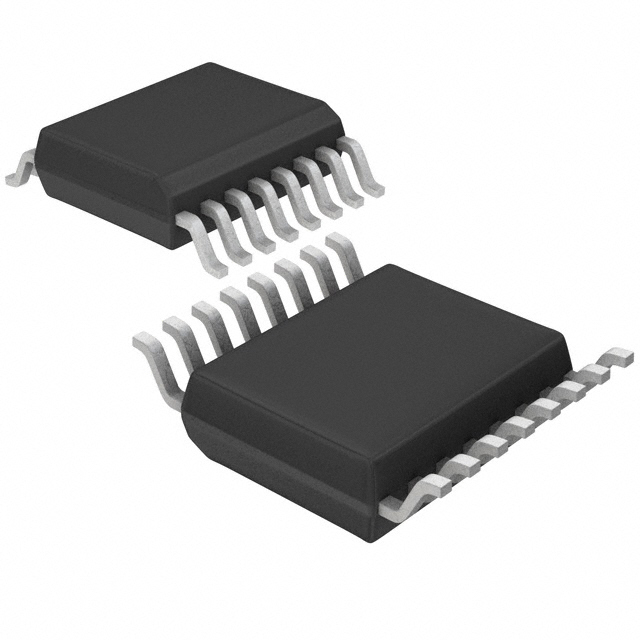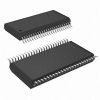Features: • Mixed 2.5V and 3.3V operation
• Complete clock solution for Pentium®, Pentium® II, Cyrix, and AMD processor-based motherboards
-Four CPU clocks at 2.5V or 3.3V
-Up to twelve 3.3V SDRAM clocks
-Seven synchronous PCI clocks, one free-running
-One 3.3V 48 MHz USB clock
-One 2.5V IOAPIC clock (-3 option only)
-Two AGP clocks at 60 or 66.6MHz (-2 option only)
-One 3.3V Ref. clock at 14.318 MHz
• I2C™ Serial Configuration Interface
• Factory-EPROM programmable output drive and slew rate for EMI customization
• Factory-EPROM programmable CPU clock frequencies for custom configurations
• Power-down, CPU stop and PCI stop pins
• Available in space-saving 48-pin SSOP packagePinout Specifications(Above which the useful life may be impaired. For user guidelines,
Specifications(Above which the useful life may be impaired. For user guidelines,
not tested.)
Supply Voltage ...............................................0.5 to +7.0V
Input Voltage .......................................... 0.5V to VDD+0.5
Storage Temperature (Non-Condensing) ...65 to +150
Max. Soldering Temperature (10 sec) ....................... +260
Junction Temperature ............................................... +150
Package Power Dissipation ..............................................1W
Static Discharge Voltage ..........................................>2000V
(per MIL-STD-883, Method 3015, like VDD pins tied together)DescriptionThe CY2273A is a clock synthesizer/driver for a Pentium, Pentium II, Cyrix, or AMD processor-based PC using Intel's 82430TX, 82440LX, ALI Aladdin IV or Aladdin IV+ chipsets.
The CY2273A-1 outputs four CPU clocks at 2.5V or 3.3V with up to 83.3MHz operation. There are seven PCI clocks, running at 30 and 33.3MHz. One of the PCI clocks is free-running.
Additionally, the part outputs up to twelve 3.3V SDRAM clocks, one 3.3V USB clock at 48 MHz, and one 3.3V reference clock at 14.318 MHz. The CY2273A-2 is similar, except that PCICLK4 and PCICLK5 are now AGP clocks. The CY2273A-3 is more suited to Pentium II systems, as it outputs one 2.5V IOAPIC clock. Finally, the CY2273A-4 is similar to the CY2273A-1 except that is supports 0-ns CPU-PCI delay.
The CY2273A possesses power-down, CPU stop, and PCI stop pins for power management control. These inputs are multiplexed with SDRAM clock outputs, and are selected when the MODE pin is driven low. Additionally, the signals are synchronized on-chip, and ensure glitch-free transitions on the outputs. When the CPU_STOP input is asserted, the CPU clock outputs are driven LOW. When the PCI_STOP input is asserted, the PCI clock outputs (except the free-running PCI clock) are driven LOW. When the PWR_DWN pin is asserted, the reference oscillator and PLLs are shut down, and all outputs are driven LOW.
The CY2273A outputs are designed for low EMI emissions.
Controlled rise and fall times, unique output driver circuits and factory-EPROM programmable output drive and slew-rate enable optimal configurations for EMI control.

 CY2273A Data Sheet
CY2273A Data Sheet









